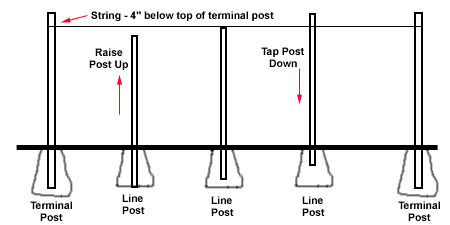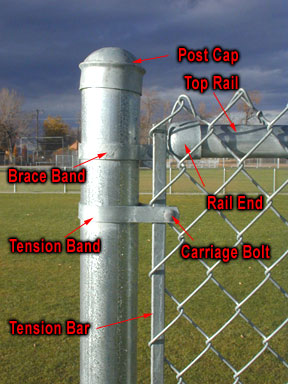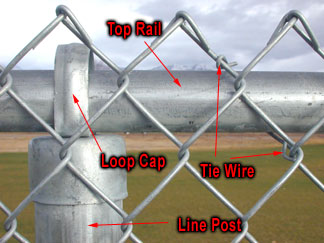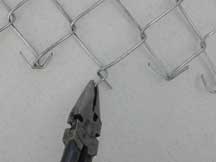Step 1 - Survey Property Lines
Be sure that the fence does not exceed property lines. Most fence
installers recommend that all posts be set approximately 4" inside
the property line. This will help avoid encroaching on adjoining
property with concrete footings. This is easily done by stretching
a string along the property line and setting the posts 4" inside.
Step 2 - Locate and set Terminal Posts (corner, end, and gate posts
are called terminal posts)
Distance between gate posts is determined by adding the actual
width of the gate plus an allowance for hinges and latches. Usually
walk gates require 3 3/4" for hinges and latches and double drive
gates require 5 1/2". Next, dig the holes. 
Terminal posts should be set 2" higher than the height of the fence
fabric and line posts 2" lower than the height of the fence fabric
(terminal posts should be 4" higher than the line posts). Set the
terminal posts in concrete using a concrete mix. You can use 1 part
cement, 2 parts sand, and 4 parts gravel. There is also pre-mix
cement. Use a level to make sure the posts are straight. Posts
should be centered in the hole. Crown posts footings so the water
will drain away from the posts.

Step 3 - Locate and set Line Posts
After the concrete around the terminal posts have hardened, stretch
a string tight between the terminal posts. The string should be 4"
below the top of the terminal posts. Line posts should not be
spaced more than 10 feet apart. For example, if the length between
two terminal posts is 30 feet, then line posts would be spaced 10
feet apart (see chart below).
Line Post Spacing Chart Space Between Terminal Posts | Set Line Posts Apart | | Space Between Terminal Posts | Set Line Posts Apart | 30 ft | 10 ft | 76 ft | 9 ft 6 in | 31 ft | 7 ft 9 in | 77 ft | 9 ft 7 in | 32 ft | 8 ft | 78 ft | 9 ft 9 in | 33 ft | 8 ft 3 in | 79 ft | 9 ft 10 in | 34 ft | 8 ft 6 in | 80 ft | 10 ft | 35 ft | 8 ft 9 in | 81 ft | 9 ft | 36 ft | 9 ft | 82 ft | 9 ft 1 in | 37 ft | 9 ft 3 in | 83 ft | 9 ft 3 in | 38 ft | 9 ft 6 in | 84 ft | 9 ft 4 in | 39 ft | 9 ft 9 in | 85 ft | 9 ft 6 in | 40 ft | 10 ft | 86 ft | 9 ft 7 in | 41 ft | 8 ft 2 in | 87 ft | 9 ft 8 in | 42 ft | 8 ft 5 in | 88 ft | 9 ft 9 in | 43 ft | 8 ft 6 in | 89 ft | 9 ft 10 in | 44 ft | 8 ft 9 in | 90 ft | 9 ft | 45 ft | 9 ft | 91 ft | 9 ft 2 in | 46 ft | 9 ft 2 in | 92 ft | 9 ft 2 in | 47 ft | 9 ft 5 in | 93 ft | 9 ft 3 in | 48 ft | 9 ft 7 in | 94 ft | 9 ft 5 in | 49 ft | 9 ft 9 in | 95 ft | 9 ft 6 in | 50 ft | 10 ft | 96 ft | 9 ft 7 in | 51 ft | 8 ft 6 in | 97 ft | 9 ft 7 in | 52 ft | 8 ft 8 in | 98 ft | 9 ft 8 in | 53 ft | 8 ft 10 in | 99 ft | 9 ft 9 in | 54 ft | 9 ft | 100 ft | 10 ft | 55 ft | 8 ft 2 in | 101 ft | 9 ft 2 in | 56 ft | 9 ft 4 in | 102 ft | 9 ft 3 in | 57 ft | 9 ft 6 in | 103 ft | 9 ft 4 in | 58 ft | 9 ft 8 in | 104 ft | 9 ft 5 in | 59 ft | 9 ft 10 in | 105 ft | 9 ft 6 in | 60 ft | 10 ft | 106 ft | 9 ft 7 in | 61 ft | 8 ft 8 in | 107 ft | 9 ft 8 in | 62 ft | 8 ft 10 in | 108 ft | 9 ft 9 in | 63 ft | 9 ft | 109 ft | 9 ft 10 in | 64 ft | 9 ft | 110 ft | 10 ft | 65 ft | 9 ft 3 in | 111 ft | 9 ft 3 in | 66 ft | 9 ft 5 in | 112 ft | 9 ft 4 in | 67 ft | 9 ft 7 in | 113 ft | 9 ft 5 in | 68 ft | 9 ft 8 in | 114 ft | 9 ft 6 in | 69 ft | 9 ft 10 in | 115 ft | 9 ft 7 in | 70 ft | 10 ft | 116 ft | 9 ft 8 in | 71 ft | 8 ft 9 in | 117 ft | 9 ft 9 in | 72 ft | 9 ft | 118 ft | 9 ft 10 in | 73 ft | 9 ft 2 in | 119 ft | 9 ft 10 in | 74 ft | 9 ft 3 in | 120 ft | 10 ft | 75 ft | 9 ft 4 in | 121 ft | 9 ft 3 in |
Dig the post holes and set the line posts. Before concrete begins
to set, adjust post height by moving post up or down. Top of the
line posts should be even with the string. Check with level to make
sure posts are straight. 
Step 4 - Apply Fittings to Terminal Posts
Check material list and fittings chart above. After all posts have
been installed and the concrete footings have hardened, slip the
tension and brace bands onto the terminal posts. The long flat
surface of the tension band should face towards the outside of the
fence. Take care not to spread or distort the fittings. Now apply
terminal post caps. 
Step 5 - Apply Top Rail
Attach loop caps to line posts. Insert one length of top rail pipe
through the eye-top closest to one of the terminal post. Slide a
rail end onto the end of the top rail and attach it to a termianl
post by using the brace band (If using swedge top rail, do not
insert the swedged end into the rail end). Secure the rail end to
the brace band with a carriage bolt. Continue by attaching top
rails together. If swedged top rail is not used, you'll connect the
rail ends together by using top rail sleeve. Upon reaching the
other terminal post, measure carefully and cut the top rail to fit
tightly into the rail end. Secure rail end to the terminal post
with brace band and carriage bolt. 
Step 6 - Hang Chain Link Fabric
Unroll the chain link fabric on the ground along the fence line.
Slide tension bar through the last link on the chain link fabric.
Stand the fabric up and lay it against the posts. Fasten the
tension bar (that you just inserted) to the terminal post with
tension bands (already on the post). Use the carriage bolts with
the head to the outside of the fence. Walk along the fence and take
the slack out. Loosely attach fabric to top rail with a few wire
ties. To connect two sections or rolls of fence fabric together - take a
single strand of wire from one of the sections of fence (Sometimes
it is necessary to remove a second wire on the one end in order for
the two sections to mesh properly.). Place the two section of fence
next to each other (end on end). Join the two sections by winding
(corkscrew fashion) the loose strand down through the fence. Join
and tighten the knuckles at bottom and top. Now you shouldn't even
be able to see where the two sections were connection together. To remove excess chain link fence fabric - untie both top and
bottom ends of fence (knuckles - pliers shown below). Twist the
wire in a corkscrew fashion until the fence comes apart. One picket
shown in red is turned until the fence is separated. 

| 

